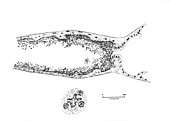Leptomonas
Leptomonas is a genus of parasitic flagellate protist belonging to family Trypanosomatidae and subfamily Leishmaniinae sensu Maslov & Lukeš 2012.[1] It is a monoxenous parasite of mainly Hemiptera, Diptera, and Siphonaptera insects.[2]
| Leptomonas | |
|---|---|
 | |
| Leptomonas etenocephali lining the lumen of intestine (longitudinal section) and Malpighan tube (transverse section) of the dog flea (Ctenocephalides canis). | |
| Scientific classification | |
| (unranked): | Excavata |
| (unranked): | Discoba |
| Superphylum: | Discicristata |
| Phylum: | Euglenozoa |
| Subphylum: | Glycomonada |
| Class: | Kinetoplastea |
| Subclass: | Metakinetoplastina |
| Order: | Trypanosomatida |
| Family: | Trypanosomatidae |
| Genus: | Leptomonas W.S.Kent, 1880 |
| Species | |
In addition to Leptomonas, one-host trypanosomatids from insects have been traditionally placed in genera Crithidia, Blastocrithidia, Herpetomonas, Rhynchoidomonas, and Wallaceina.[3][4]
Systematics
The etymology of the genus name Leptomonas derives from the two Ancient Greek words λεπτός (leptós), meaning "fine-grained, tiny", and μονάς (monás), meaning "alone, isolated" (as an adjective), or "a unit" (as a name).[5][6]
There are 18 species of Leptomonas.[7][8]
- Leptomonas agilis Chatton
- Leptomonas brasiliense (Franchini) França
- Leptomonas buetschlii W.S. Kent
- Leptomonas ciliatorum H.-D. Görtz & J. Dieckmann, 1987
- Leptomonas costoris Wallace, Todd & Rogers
- Leptomonas davidi Lafont
- Leptomonas gerridis (Patton) Berliner
- Leptomonas karyophilus Gillies & Hanson
- Leptomonas lata Skvortzov
- Leptomonas leptoglossi Hanson & McGhee
- Leptomonas lunulata Massart
- Leptomonas lygaei (Patton) Berliner
- Leptomonas melophagia (Flu) Berliner
- Leptomonas mesnili Roubaud
- Leptomonas muscae-domesticae (Diesing) Senn
- Leptomonas pangoniae Rodhain, Pons, Vandenbranden & Bequaert
- Leptomonas pisciformis Skvortzov
- Leptomonas soudanensis Roubaud
gollark: No, it's `contemporary advantages look like obvious crabs`.
gollark: Or `contemporary`.
gollark: The `c` is `cool`.
gollark: SMH my head, non-length-terminated strings.
gollark: * k🐝
References
- Týč, Jiří; Votýpka, Jan; Klepetková, Helena; Šuláková, Hana; Jirků, Milan; Lukeš, Julius (2013-10-01). "Growing diversity of trypanosomatid parasites of flies (Diptera: Brachycera): Frequent cosmopolitism and moderate host specificity". Molecular Phylogenetics and Evolution. 69 (1): 255–264. doi:10.1016/j.ympev.2013.05.024. ISSN 1055-7903.
- Tanada, Yoshinori; Kaya, Harry K. (2012-12-02). Insect Pathology. Academic Press. p. 397. ISBN 978-0-08-092625-4.
- Merzlyak, Ekaterina; Yurchenko, Vyacheslav; Kolesnikov, Alexander A.; Alexandrov, Kirill; Podlipaev, Sergei A.; Maslov, Dmitri A. (2001-03-01). "Diversity and Phylogeny of Insect Trypanosomatids Based on Small Subunit rRNA Genes: Polyphyly of Leptomonas and Blastocrithidia". The Journal of Eukaryotic Microbiology. 48 (2): 161–169. doi:10.1111/j.1550-7408.2001.tb00298.x. ISSN 1066-5234. PMID 12095103.
- Yurchenko, Vyacheslav Y.; Lukeš, Julius; Tesařová, Martina; Jirků, Milan; Maslov, Dmitri A. (2008-01-01). "Morphological Discordance of the New Trypanosomatid Species Phylogenetically Associated with the Genus Crithidia". Protist. 159 (1): 99–114. doi:10.1016/j.protis.2007.07.003. PMID 17931968.
- Bailly, Anatole (1981-01-01). Abrégé du dictionnaire grec français. Paris: Hachette. ISBN 978-2010035289. OCLC 461974285.
- Bailly, Anatole. "Greek-french dictionary online". www.tabularium.be. Retrieved April 19, 2020.
- "IRMNG - Leptomonas W.S. Kent, 1880". www.irmng.org. Retrieved 2020-04-17.
- "Leptomonas W.S.Kent, 1880 :: Algaebase". www.algaebase.org. Retrieved 2020-04-17.
This article is issued from Wikipedia. The text is licensed under Creative Commons - Attribution - Sharealike. Additional terms may apply for the media files.